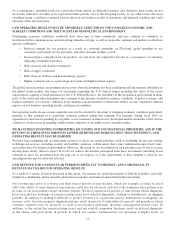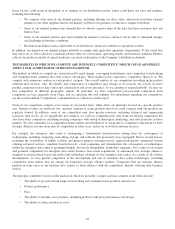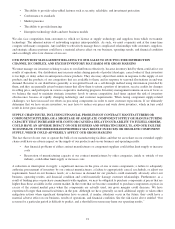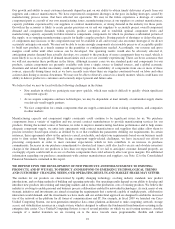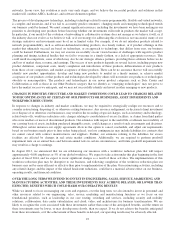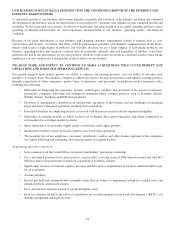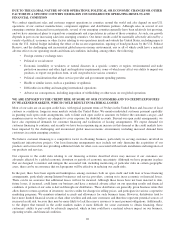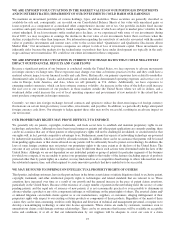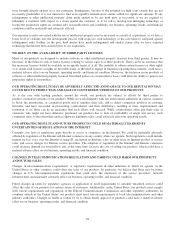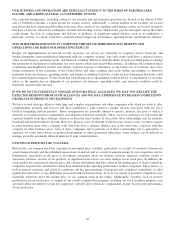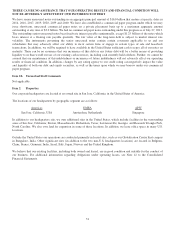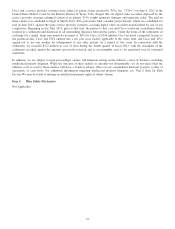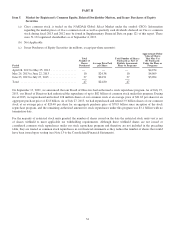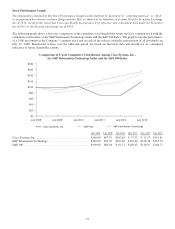Cisco 2013 Annual Report Download - page 35
Download and view the complete annual report
Please find page 35 of the 2013 Cisco annual report below. You can navigate through the pages in the report by either clicking on the pages listed below, or by using the keyword search tool below to find specific information within the annual report.WE ARE EXPOSED TO FLUCTUATIONS IN THE MARKET VALUES OF OUR PORTFOLIO INVESTMENTS
AND IN INTEREST RATES; IMPAIRMENT OF OUR INVESTMENTS COULD HARM OUR EARNINGS
We maintain an investment portfolio of various holdings, types, and maturities. These securities are generally classified as
available-for-sale and, consequently, are recorded on our Consolidated Balance Sheets at fair value with unrealized gains or
losses reported as a component of accumulated other comprehensive income, net of tax. Our portfolio includes fixed income
securities and equity investments in publicly traded companies, the values of which are subject to market price volatility to the
extent unhedged. If such investments suffer market price declines, as we experienced with some of our investments during
fiscal 2009, we may recognize in earnings the decline in the fair value of our investments below their cost basis when the
decline is judged to be other than temporary. For information regarding the sensitivity of and risks associated with the market
value of portfolio investments and interest rates, refer to the section titled “Quantitative and Qualitative Disclosures About
Market Risk.” Our investments in private companies are subject to risk of loss of investment capital. These investments are
inherently risky because the markets for the technologies or products they have under development are typically in the early
stages and may never materialize. We could lose our entire investment in these companies.
WE ARE EXPOSED TO FLUCTUATIONS IN CURRENCY EXCHANGE RATES THAT COULD NEGATIVELY
IMPACT OUR FINANCIAL RESULTS AND CASH FLOWS
Because a significant portion of our business is conducted outside the United States, we face exposure to adverse movements
in foreign currency exchange rates. These exposures may change over time as business practices evolve, and they could have a
material adverse impact on our financial results and cash flows. Historically, our primary exposures have related to nondollar-
denominated sales in Japan, Canada, and Australia and certain nondollar-denominated operating expenses and service cost of
sales in Europe, Latin America, and Asia, where we sell primarily in U.S. dollars. Additionally, we have exposures to
emerging market currencies, which can have extreme currency volatility. An increase in the value of the dollar could increase
the real cost to our customers of our products in those markets outside the United States where we sell in dollars, and a
weakened dollar could increase the cost of local operating expenses and procurement of raw materials to the extent that we
must purchase components in foreign currencies.
Currently, we enter into foreign exchange forward contracts and options to reduce the short-term impact of foreign currency
fluctuations on certain foreign currency receivables, investments, and payables. In addition, we periodically hedge anticipated
foreign currency cash flows. Our attempts to hedge against these risks may not be successful, resulting in an adverse impact on
our net income.
OUR PROPRIETARY RIGHTS MAY PROVE DIFFICULT TO ENFORCE
We generally rely on patents, copyrights, trademarks, and trade secret laws to establish and maintain proprietary rights in our
technology and products. Although we have been issued numerous patents and other patent applications are currently pending, there
can be no assurance that any of these patents or other proprietary rights will not be challenged, invalidated, or circumvented or that
our rights will, in fact, provide competitive advantages to us. Furthermore, many key aspects of networking technology are governed
by industrywide standards, which are usable by all market entrants. In addition, there can be no assurance that patents will be issued
from pending applications or that claims allowed on any patents will be sufficiently broad to protect our technology. In addition, the
laws of some foreign countries may not protect our proprietary rights to the same extent as do the laws of the United States. The
outcome of any actions taken in these foreign countries may be different than if such actions were determined under the laws of the
United States. Although we are not dependent on any individual patents or group of patents for particular segments of the business
for which we compete, if we are unable to protect our proprietary rights to the totality of the features (including aspects of products
protected other than by patent rights) in a market, we may find ourselves at a competitive disadvantage to others who need not incur
the substantial expense, time, and effort required to create innovative products that have enabled us to be successful.
WE MAY BE FOUND TO INFRINGE ON INTELLECTUAL PROPERTY RIGHTS OF OTHERS
Third parties, including customers, have in the past and may in the future assert claims or initiate litigation related to exclusive patent,
copyright, trademark, and other intellectual property rights to technologies and related standards that are relevant to us. These
assertions have increased over time as a result of our growth and the general increase in the pace of patent claims assertions,
particularly in the United States. Because of the existence of a large number of patents in the networking field, the secrecy of some
pending patents, and the rapid rate of issuance of new patents, it is not economically practical or even possible to determine in
advance whether a product or any of its components infringes or will infringe on the patent rights of others. The asserted claims and/
or initiated litigation can include claims against us or our manufacturers, suppliers, or customers, alleging infringement of their
proprietary rights with respect to our existing or future products or components of those products. Regardless of the merit of these
claims, they can be time-consuming, result in costly litigation and diversion of technical and management personnel, or require us to
develop a non-infringing technology or enter into license agreements. Where claims are made by customers, resistance even to
unmeritorious claims could damage customer relationships. There can be no assurance that licenses will be available on acceptable
terms and conditions, if at all, or that our indemnification by our suppliers will be adequate to cover our costs if a claim
27


